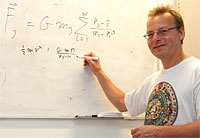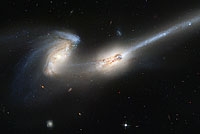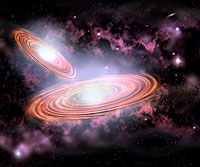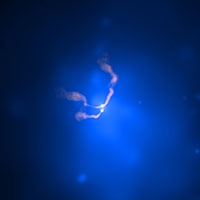
What happens when two galaxies collide?
When galaxies collide, do the black holes at their centre form a supersized black hole? This is what we think happens, but it's not as simple as that, according to Simon Portegies Zwart. Zwart, computer scientist and astronomer, has been awarded a VICI grant to research this phenomenon.
A billion sun masses

Galaxies increase in size slowly, colliding with one another or merging together. As a result, they become heavier. The core of every galaxy contains a black hole that can be as masive as a billion sun masses. The black hole in our galaxy is three to four million times more massive than the sun. We don't know how they form, but the black holes in large galaxies are even heavier. This indicates a correlation between the mass of the black hole and that of the galaxy.
Double black holes

Binding energy
The interaction between the black holes and the stars forces the black holes towards one another. They then form a double black hole, around which the stars revolve. If a star comes too close, it is flung away at high speed, using binding energy drawn from the double black hole. The black holes are then pulled towards one another. At a certain point in time, there are no more stars to be propelled away.
Gravitational radiation

University lecturer
As well as being an astronomer, Portegies Zwart is also an information technologist. Until recently, he was a university lecturer in Amsterdam. Leiden offered him a professorship of an endowed chair, but when he was awarded a Vici grant, this became an appointment as a full professor. He is the first University lecturer in Leiden to become a full professor directly. 'There are two movements in Dutch astronomy,' he explains. 'Amsterdam, Utrecht and Nijmegen focus primarily on stars and double stars; Leiden and Groningen study galaxies and cosmology. There is little overlap or cross-fertilisation between these two movements. When Ed van den Heuvel retired in Amsterdam, there was less support for my research, while Leiden is much more focused on my specialist area: computational stellar dynamics.'
Interaction

A galaxy contains roughly 100 billion stars, although it's not possible to simulate them at the level of each individual star. So far, two different methods have been applied. The first assumes a galaxy of ten million stars. Each star then represents a clump of stars. The black holes are just as heavy as the other objects. But this method doesn't allow the interaction between the black holes and the stars to be taken into account in sufficient detail.
Soup
The second method uses a more detailed system. 'This system assumes the galaxies have already collided, producing a soup of stars,' Portegies Zwart explains, 'with the two black holes in the centre. But the starting conditions of this method are too artificial: a spherical, symmetrical group of stars ideally balanced, with two black holes in an orbit. But these black holes cannot collide, because there are not enough stars within the system. I can also calculate this on paper.'
Graphics cards
The basis of the simulation, in fact, has to be the actual size: two galaxies containing a black hole. Portegies Zwart: ‘You then calculate the whole system until the black holes collide. It's not as easy as it sounds, because you have to include all 100 billion stars. New developments in computer science make these kinds of calculations possible. These are the recent algorhythmic developments and the use of graphical procesing units which are commonly used in computer games. These cards are very quick and ideally suited for calculating gravity.'
Challenge
‘We are going to construct a parallel computer using a lot of these graphics cards. You can't completely calculate the extent of a real galaxy with this, because 100 billion stars is a very big challenge. A second step is needed: a link made up of different codes to calculate the movement dynamics of stars. This link is available, a very precise calculation for stars in the neighbourhood of a black hole and a less precise, but faster one for stars further away. What's important is what stars in the neighbourhood of the black hole do. Whatever the outcome, it will certainly provide some new information. If the two black holes collide, then the problem is solved, If they don't collide, there must be something else going on, in which case we have to look further.'
(14 July 2009)
